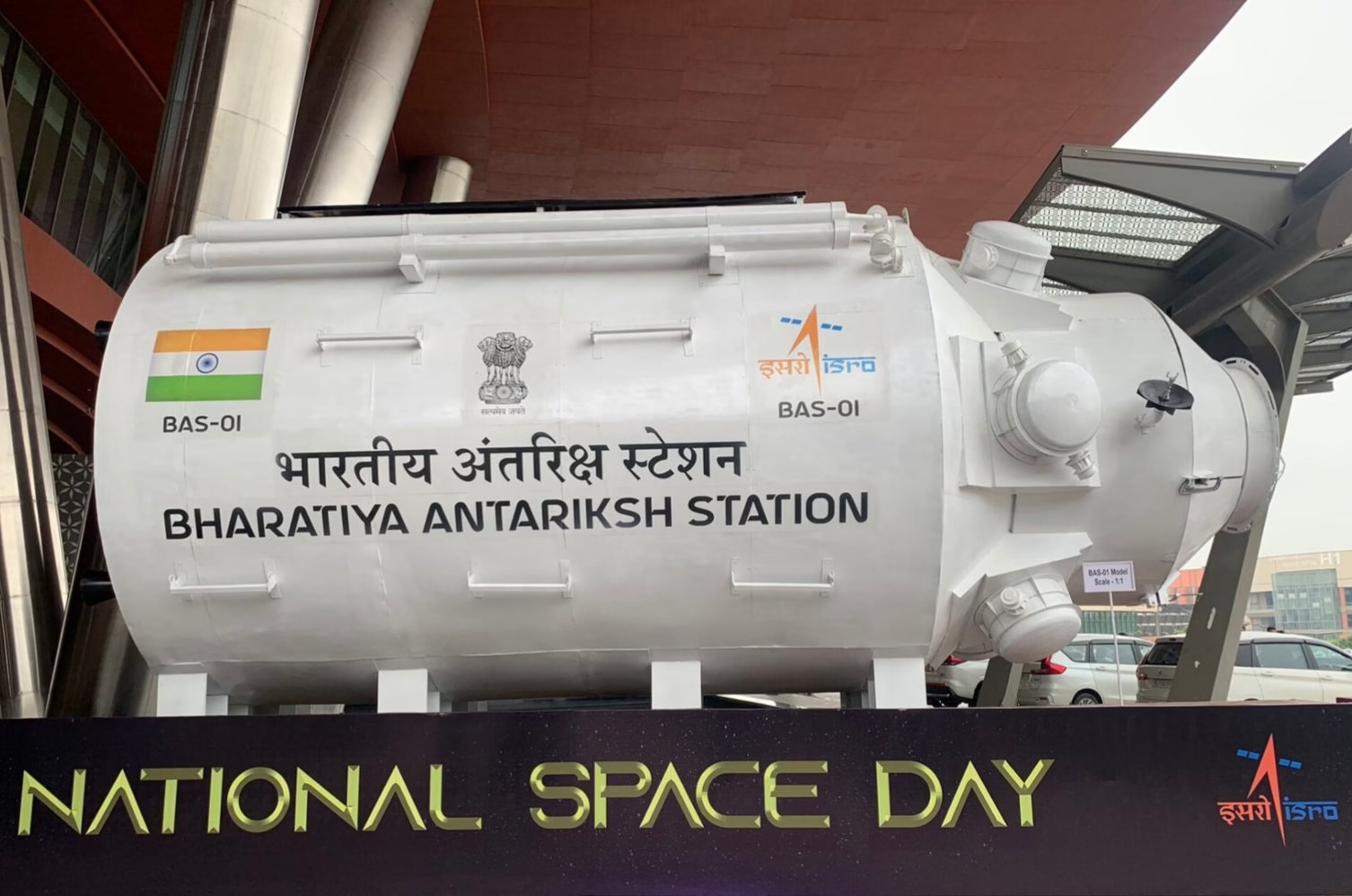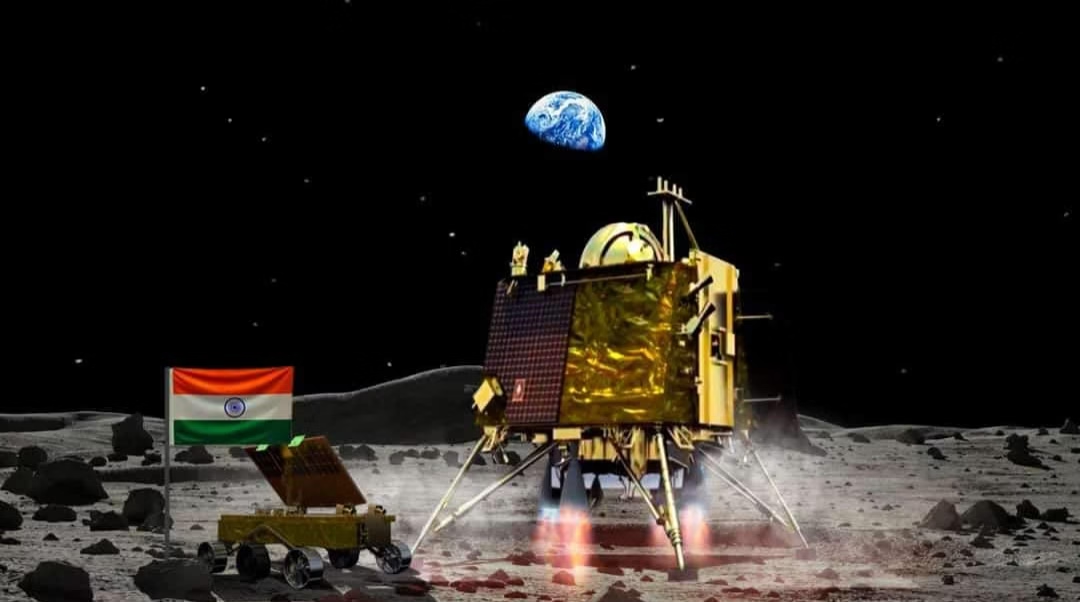The first full-scale 1:1 model of the Bharatiya Antariksh Station first module is now on display at Bharat Mandapam, New Delhi. Weighing 52 tons, the space station will be built with five modules launched on LVM3 rockets between 2028 and 2035.

Experience the True Size of the Bharatiya Antariksh Station: India Unveils 1:1 Scale Model of First Module
India’s ambitious journey into the future of human space exploration has taken another giant leap with the unveiling of the first-ever life-size 1:1 scale model of the Bharatiya Antariksh Station (BAS). Displayed at the prestigious Bharat Mandapam in New Delhi, this full-scale model represents the very first module of what will become India’s permanent space station in low Earth orbit.
The display not only symbolizes India’s readiness for long-duration human spaceflight but also gives the public a tangible sense of the sheer size and technological complexity of the project. The BAS is expected to redefine India’s role in space exploration and open new frontiers in science, technology, and international cooperation.
The Unveiling of the 1:1 Scale Module: Bharatiya Antariksh Station
Visitors at Bharat Mandapam are now witnessing history with their own eyes. The 1:1 scale model has been carefully designed to replicate the actual dimensions of the first BAS module.
- Weight of actual module: 52 tons
- Planned number of modules: 5
- Launch vehicle: LVM3 (GSLV Mk-III)
- Timeline: Five launches between 2028 and 2035
The model is so massive that standing next to it, humans look minuscule in comparison. This direct visual comparison helps people understand what astronauts will experience aboard India’s first space station.
A Vision Rooted in India’s Space Roadmap
The BAS is part of India’s long-term spaceflight roadmap announced by ISRO, following the success of missions like Chandrayaan, Mangalyaan, and the upcoming Gaganyaan human spaceflight program.
While Gaganyaan will send Indian astronauts into orbit for short-duration missions, the BAS represents the next evolutionary step—enabling continuous human presence in space. This leap mirrors the trajectories of other spacefaring nations that first proved human spaceflight and then built stations to support extended missions.
Technical Overview of the Bharatiya Antariksh Station
The BAS is envisioned as a modular orbital outpost, built and expanded in phases.
1. Modules
- Each module weighs approximately 52 tons.
- A total of five modules will be launched using India’s heavy-lift rocket LVM3.
- These modules will be assembled in orbit over seven years (2028–2035).
2. Launch Vehicle: LVM3
- ISRO’s LVM3 has already established itself as a reliable heavy-lift vehicle.
- Capable of carrying payloads of up to 10 tons to low Earth orbit, it will be central to delivering and assembling BAS.
3. Station Capabilities
- Crew capacity: Initially 3 astronauts, expandable with more modules.
- Orbit: Expected to operate in low Earth orbit (LEO) around 400 km altitude.
- Life support systems: Designed for long-duration human habitation with oxygen generation, water recycling, and radiation shielding.
- Research facilities: Equipped with laboratories for microgravity experiments, materials research, biology, medicine, and astronomy.
4. Assembly Plan
- Phase 1 (2028): First module launch.
- Phase 2 (2030): Addition of second and third modules.
- Phase 3 (2033–2035): Remaining modules launched to complete the station.
Why the BAS Matters for India
The Bharatiya Antariksh Station is more than just a symbol of scientific achievement. It will play a transformative role across multiple domains:
1. Scientific Research
- Microgravity studies will open new frontiers in medicine, materials science, and physics.
- Biological experiments could provide breakthroughs in drug development and human health.
2. Technology Development
- Building and operating BAS will advance India’s capabilities in life support systems, robotics, docking technologies, and long-duration spaceflight.
- These technologies are stepping stones toward future missions to the Moon and Mars.
3. Strategic Significance
- With BAS, India will join the select group of nations (USA, Russia, China) capable of sustaining human presence in space.
- It will enhance India’s geopolitical standing and open doors to international partnerships.
4. Commercial and Industrial Growth
- The BAS will drive innovation in India’s private space sector.
- Opportunities in space manufacturing, satellite servicing, and space tourism could emerge.
Public Engagement and Inspiration
The decision to unveil the 1:1 scale model at Bharat Mandapam is deeply symbolic. It brings space closer to the people, allowing them to visualize India’s future in orbit.
Students, researchers, and visitors can directly engage with the model, inspiring the next generation of scientists and engineers. For a country with a vast youth population, this exposure is invaluable.
The sight of the module dwarfed by human figures also resonates with the idea that space exploration requires vision, courage, and teamwork on a monumental scale.
Learning from Global Counterparts
India’s BAS will follow in the footsteps of other international stations but with a uniquely Indian vision.
- Mir (Russia): Pioneered modular space station design in the 1980s.
- International Space Station (ISS): The largest multinational collaboration in space, serving as a hub for research since 2000.
- Tiangong (China): Demonstrates how a single nation can develop and operate its own long-term orbital facility.
The BAS will build upon these lessons while incorporating cost-effective, indigenous solutions—a hallmark of ISRO’s approach.
Challenges Ahead
Building and operating a space station is not without hurdles:
- Heavy Payload Delivery – Each BAS module is 52 tons, requiring precision launches.
- Docking & Assembly in Orbit – Mastering robotic and crew-assisted assembly in space.
- Sustaining Astronaut Health – Long-duration exposure to microgravity poses risks like muscle loss and radiation effects.
- Funding & International Collaboration – Ensuring consistent government funding and inviting global partners will be essential.
ISRO, however, has consistently turned challenges into opportunities. The success of Chandrayaan-3, Aditya-L1, and other missions demonstrates the organization’s resilience and capability.
Timeline Toward Reality
- 2025: Display of 1:1 scale model at Bharat Mandapam.
- 2026–2027: Testing of advanced life support and docking systems.
- 2028: Launch of the first BAS module on LVM3.
- 2030: Expansion with second and third modules.
- 2035: Full operational capability with five modules assembled in orbit.
By mid-2030s, India could have its own fully functional space station, capable of hosting astronauts for months at a stretch.
Impact on India’s Space Future
The BAS is not an isolated project. It fits into a broader framework of India’s space ambitions:
- Gaganyaan Mission (2026): Human spaceflight capability demonstration.
- Lunar and Mars Missions: Testing technologies needed for deep space exploration.
- Space Economy Growth: India’s space economy is projected to reach $40 billion by 2040, with BAS playing a central role.
This integrated roadmap ensures that every milestone builds toward a sustainable, long-term space presence.
https://x.com/isro/status/1955973442672459810?t=SulT5c5Lb7O_8q_FXcnp0w&s=19
Conclusion: Bharatiya Antariksh Station
The unveiling of the 1:1 scale model of the Bharatiya Antariksh Station at Bharat Mandapam is a landmark moment. It offers the public a chance to experience the sheer magnitude of India’s first space station, while also underlining the nation’s determination to move from short-term missions to permanent human presence in space.
With its first module weighing 52 tons and the entire station planned through five LVM3 launches between 2028 and 2035, the BAS reflects India’s evolving identity as a spacefaring nation ready to contribute meaningfully to humanity’s exploration of the cosmos.
As visitors gaze up at the towering module on display, they are not just looking at a structure—they are witnessing India’s future in space.
FAQs about the Bharatiya Antariksh Station (BAS) 1:1 Scale Model Display
Q1. What is the Bharatiya Antariksh Station (BAS)?
The Bharatiya Antariksh Station (BAS) is India’s planned national space station, to be developed and launched by ISRO. It will serve as a long-term orbital research outpost for scientific experiments, technology demonstrations, and human spaceflight.
Q2. Where is the 1:1 scale model of the BAS module displayed?
The first-ever 1:1 scale model of the BAS’s initial module is currently on display at the Bharat Mandapam convention center in New Delhi.
Q3. Why is the BAS 1:1 model significant?
The full-scale model allows the public, students, and policymakers to experience the true size and design of the station. It also highlights India’s progress toward its ambitious human space exploration goals.
Q4. How big is the BAS module on display?
The displayed module weighs about 52 tons and has been built to full 1:1 scale. This is the same size as the module that will actually be launched into orbit.
Q5. How many modules will the Bharatiya Antariksh Station have?
The complete space station will be made up of five modules. These will be assembled in orbit to form the full station.
Q6. When will the Bharatiya Antariksh Station be launched?
The modules of the BAS are planned to be launched aboard India’s LVM3 rockets between 2028 and 2035.
Q7. How will the modules be launched and assembled?
Each module will be launched separately on ISRO’s LVM3 heavy-lift rocket. Once in orbit, astronauts and robotic systems will assist in assembling the modules to form the full station.
Q8. How does BAS compare to the International Space Station (ISS)?
While smaller than the ISS, BAS is designed for India’s needs, focusing on long-duration human spaceflight, life science experiments, Earth observation, and space technology development.
Q9. What kind of research will be conducted on BAS?
BAS will host experiments in microgravity, material science, astronomy, life sciences, space medicine, and climate studies. It will also help test technologies needed for deep-space missions.
Q10. Why is India building its own space station?
India’s own station will provide independence in space research, strengthen human spaceflight capabilities, and position the country as a global leader in space exploration.
Q11. Who designed the Bharatiya Antariksh Station?
The design and development of BAS is being led by ISRO, with collaboration from Indian industries, academic institutions, and potentially international partners.
Q12. Can the public visit the BAS model at Bharat Mandapam?
Yes, the display at Bharat Mandapam is open for visitors during the event period, allowing people to see the full-scale model and learn about India’s future in space.

